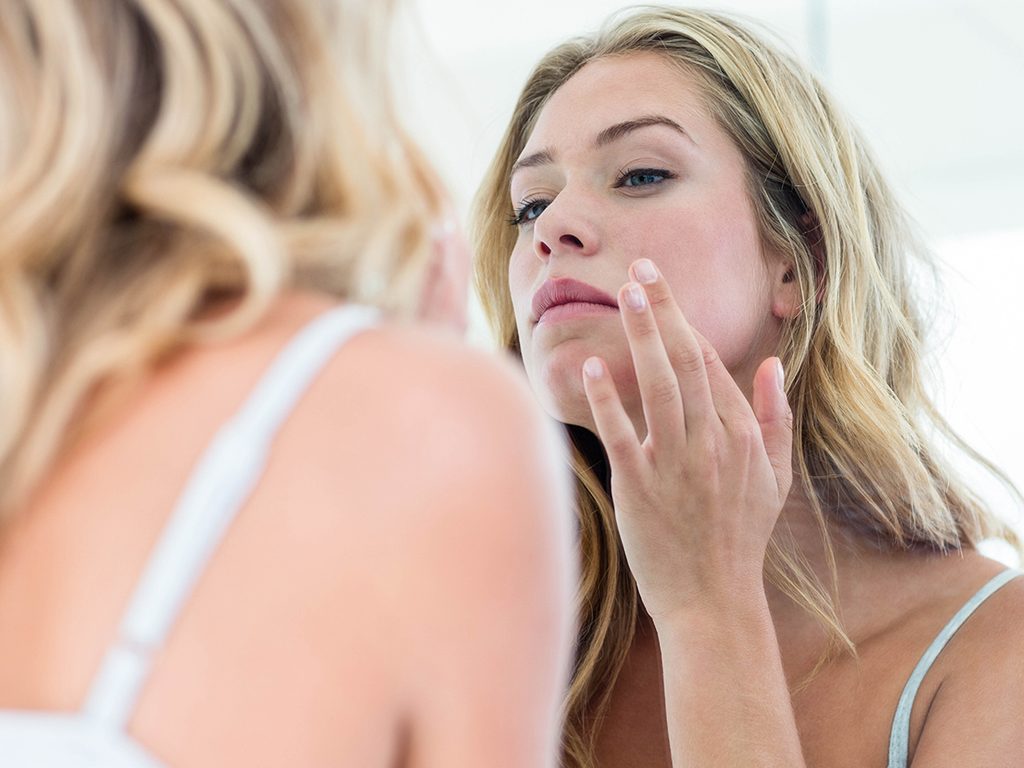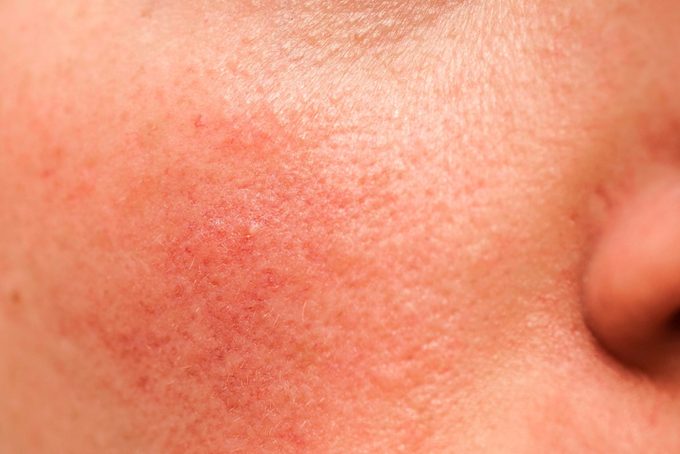Could You Have Rosacea? Here Are the Symptoms and Treatments

This skin condition can cause you to have persistent redness on your face, including red spots or bumps and flushing of the skin. Here are the symptoms, treatments, and home remedies for rosacea.
Everyone gets red in the face from time to time, whether from heat, sunburn, or blushing from embarrassment. But if your face is persistently red, it could be a skin condition called rosacea.
“Rosacea is a chronic skin condition characterized by redness and bumps on the face,” says Channa Ovits, MD, a board-certified dermatologist at Westmed Medical Group in Westchester, New York. “Rosacea is common, affecting about 5 to 10 percent of the population, or at least 16 million Americans.”
For reasons that aren’t entirely clear, rosacea most frequently occurs in middle-aged, fair-skinned women, but it can affect people of all ages and all skin types. And although it isn’t life-threatening, rosacea can do a number on your quality of life.
In one 2019 survey from the National Rosacea Society, more than 88 percent of people surveyed said their rosacea had attracted unwanted attention, and two-thirds said they avoided social situations because of their condition. But there is hope. “Getting control of rosacea will take time and effort, but will allow you the freedom to feel more confident in your skin,” Dr. Ovits says.
Read on for more about rosacea, and how you can feel comfortable showing your face again.
(Related: What You Need to Know About Rosacea, Straight From a Dermatologist)
Rosacea signs and symptoms
Rosacea is an inflammatory condition that has four main subtypes.
Flushing and facial redness: Many people who have rosacea often blush or flush, with their cheeks turning red. This redness and warmth comes and goes and is often an early sign of rosacea. This is also known as erythematotelangiectatic rosacea.
Bumps and pimples: Papulopustular rosacea is characterized by spots on the mouth, nose, and forehead that look like acne breakouts. They’re usually red, solid bumps or pus-filled pimples. The irritation is caused by inflammation.
Thickened skin: Skin on the face, particularly around the nose, can thicken and become bumpy. Known as phymatous rosacea, this is most common in men.
Irritated eyes: Also called ocular rosacea, your eyes may be watery and bloodshot and your eyelids can be swollen.
Additional symptoms may include burning, swelling, dryness, and stinging.
“People with rosacea can have any combination of those symptoms, and don’t typically have all of them,” says Dr. Ovits. “The physiological cause is not perfectly clear, though the inflamed blood vessels are responsible for a lot of the symptoms, including the flushing and visible blood vessels.”
Over time, the redness can become more permanent in the center of the face.

Rosacea triggers
Rosacea on cheeks often appears as sudden, red flushing, and is often triggered by something in the environment. “Those triggers can be spicy foods, red wine, hot food, changes of emotion, changes in temperature, hormonal fluctuations,” says Mona Gohara, MD, a board-certified dermatologist in Connecticut and an associate clinical professor in the department of dermatology at Yale School of Medicine.
Some people might have very specific triggers like citrus foods, caffeine, or even tomatoes. Stress can also bring on flushing. “People will be, like, ‘I’m in a board meeting and I’m presenting,’ and they’re stressed or they’re hot, and they feel their face flush,” she says.
In a vicious cycle, when emotional triggers bring on redness, the embarrassment it creates can make matters even worse. “As strong emotion is a trigger for rosacea, it tends to flare at the worst possible moments, causing significant distress and self-consciousness,” Dr. Ovits says.
(Related: Did you know sugar can cause skin inflammation?)
Rosacea causes
The underlying reason people get rosacea is poorly understood. “There is no clear cause of rosacea, but it is likely a combination of hereditary and environmental factors,” Dr. Ovits says. “Contributing factors include overly sensitive blood vessels, alterations in the immune response of the skin, as well as a mite that lives on everyone’s skin, which can cause an inflammatory response for some people.”
This mite, called Demodex folliculorum, has been found in high numbers on the skin of rosacea patients; experts aren’t sure why.
There also may be an association with menopause. “Although men and women get it, it could be a hormonally mediated thing,” says Dr. Gohara. “One of the reasons why people may notice it more in their fifties and forties is because that’s when women have hot flashes. There are drastic fluctuations where they’re feeling okay, and then the next minute they’re boiling hot and their skin flushes.”
Genetic factors may also play a role. “The prevalence of rosacea in individuals of northern European descent suggests a genetic predisposition that may be triggered by ultraviolet light exposure,” says dermatologist Jason A. Clark, MD, adjunct assistant professor of dermatology at Emory University.
But people of other backgrounds can have rosacea, too. It may be that the condition is just harder to see on darker skin. “We have traditionally identified rosacea in patients of northern European descent,” says Dr. Clark. “But new data suggests we have been missing individuals of Asian, Latinx, and African ancestry suffering with this vexing skin condition.”
Although rosacea is inflammatory, there’s no evidence to suggest it’s an autoimmune disease, in which the body may be attacking itself.
“There’s been a lot of speculation about rosacea and its associations, but nothing that’s been scientifically proven,” says Dr. Gohara, echoing the results of a study published in 2016 in the Journal of the American Academy of Dermatology. “People think it could look like an autoimmune condition, but there’s been no proven association between rosacea and an autoimmune tendency as of yet.”
(Related: What Your Skin Reveals About Your Health)
Rosacea treatments
Fortunately, there are new and effective prescription treatments for rosacea. “Topical and oral therapies, as well as laser therapies, can treat rosacea,” Dr. Ovits says. “Topical treatments address the underlying mechanisms of rosacea by decreasing inflammation, decreasing mite burden, or shrinking down some of those dilated blood vessels to decrease redness.”
Oral treatments include antibiotics that work as anti-inflammatory agents for the skin, similarly to some acne medications.
For a more permanent solution to redness, “laser treatments that specifically target blood vessels can greatly reduce both background redness and visible blood vessels,” Dr. Ovits says. “Rosacea is chronic so it is not cured, but it can be controlled.”
(Related: 14 Food Rules of an Anti-Inflammatory Diet)
Rosacea home remedies
Avoiding triggers is arguably the best way to avoid flares, “though this is far easier said than done,” admits Dr. Ovits. Some things, like temperature changes, you can’t really avoid. But if, for example, you know a particular spicy food brings it on, don’t eat it. In general, though, Dr. Gohara says there’s not a specific “anti-rosacea diet,” besides eating healthy.
In addition, take care of your face with a very gentle rosacea-specific skin-care routine. Dr. Gohara recommends using non-soap, pH-neutral cleansers, and skipping the chemical peels, anti-aging creams, and fun skin masks.
Something you can use? “Conceal with green pigmented makeup to counteract redness,” suggests Dr. Ovits. (It doesn’t actually look green on your skin, but has a green base.)
And don’t forget sunscreen, both doctors say, as the sun can be a trigger.
(Related: The Benefits of a Stripped Down Skin-Care Routine)
When to see a dermatologist
Although you can use these lifestyle changes to help calm your rosacea, it’s still best to see a dermatologist to get a proper diagnosis and determine the best course of treatment.
“So many patients come in and say, ‘I have sensitive skin,’ ” says Dr. Gohara. “That’s a euphemism for something else that’s going on. You need to tease through that and, generally, a dermatologist is the best person to do that.”
Plus, seeing a doctor is important because you may need prescription meds in addition to lifestyle changes. “Prescription products from your dermatologist can help tremendously, in a way that over-the-counter medications simply cannot,” says Tanya Kormeili, MD, a board-certified dermatologist in Santa Monica, California. “Nothing beats expert evaluation. If you cannot fix an issue yourself, take comfort in knowing that dermatologists have spent over 13 years in school to help you.”
Next: A Decade-by-Decade Guide to Changing Up Your Skin Care Routine




